On the 40th death anniversary of the English novelist E. M. Forster, Russell Bowden recalls his Colombo production, four decades ago, of a dramatisation of the writer’s most famous novel. Stephen Prins reports
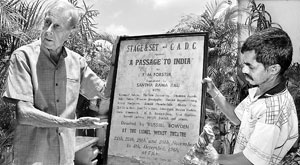
Russell Bowden takes out a poster of his 1968 production at the Lionel Wendt Theatre of “A Passage To India”. Pic by Sanka Vidanagama |
FORTY-EIGHT years ago, in the early Sixties, two Englishmen (actually, one was Welsh) crossed paths in India in the course of their separate lines of duty and became close friends. They worked for the same widespread and influential British organisation – one as a librarian, the other as an English teacher.
The librarian was based in Delhi, and the teacher had come out to India to get over a traumatic experience in Myanmar (then Burma) – the notorious July 7, 1962 incident, in which the military broke up a peaceful student protest on the campus of Rangoon University and killed more than 100 young people. Among the dead were students and friends of the teacher. India was a healing ground, and the teacher would later teach others, as he did his librarian friend, to appreciate the wonders of India.
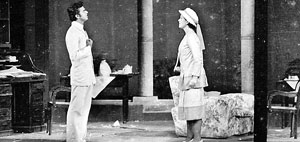
East is East, West is West: Dhamma Jagoda as Dr. Aziz and Sally James as Adela Quested. |
They were not your typical Englishmen in India, which was perhaps the main binding factor between them. Both shared a mixture of pride and embarrassment about the story of Empire. Theirs was an apologetic, post-colonial awkwardness, an overall uncertainty about the ultimate benefits of the great imperial experience and the confusing sum of its contradictory parts. This was some two decades after India had gained Independence.
The other binding factor in the relationship was a profound love of books, and of literature. The Welshman had left behind a job as professor of English literature at Rangoon University, and the Englishman was overseeing the movement of thousands of books between some 18 libraries scattered across the subcontinent. Both were attached to the British Council. After some months of teaching English at an Army outpost on the edge of a jungle in Panchmahri, in Madhya Pradesh, the Welshman came down to Delhi to take up a teaching job at St. Stephen’s College, a constituent college of Delhi University.
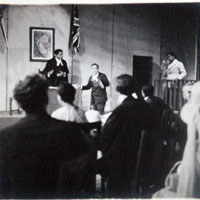
Act 3: The Magistrate’s court – Aziz on trial. |
The two Delhi-based friends could now spend more time together. They went out of their way to befriend Indians, and travelled widely in order to understand the country better.
Three years later, in 1966, it was time for them to move on to their next British Council postings, and they parted ways ahead of taking up their subsequent overseas assignments. As it turned out, they did not have a lot of sea to cross. Serendipitously (how that radiant, Serendib-begotten word keeps coming back), they found themselves stationed right next door – in Ceylon, formerly known as Serendib.
One turned up in Colombo some months after the other. The teacher, not knowing what the British Council had in store for him, had gone back to England for a break, while the librarian flew directly from Mumbai (then Bombay) to Colombo. Coincidentally, the British Council had put Russell Bowden and Raymond Adlam together again, unaware that they had been confreres back in India.
Russell Bowden took up the job of British Council Librarian, at Stuart House, Kollupitiya, while Raymond Adlam was assigned to the Ministry of Education to advise on the teaching of English as a second language.
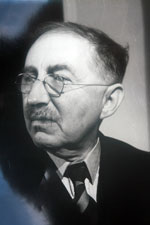
E. M. Forster remembered:
Photo study by Jane Bown |
Needless to say, the friends were delighted to be on the same turf, once again, and immediately picked up their literary conversation from where they had left off.
They had many shared interests – music, opera, literature and the theatre. Both had been amateur thespians back in England. Mr. Bowden had trained at the Central School of Speech and Drama in London, while Mr. Adlam had been involved in drama societies in Cambridge, where he was a student; at one point he had worked in the same theatre company as fellow Welshman, the film and Shakespearean actor, Richard Burton.
Theatre and books consumed their conversation, but there was one book in particular that held a strongly personal resonance for them. It became a reference, something to repeatedly turn to for illumination of the Englishman’s predicament in India. The book mirrored the complexities and frustrations of the Anglo-Indian experience, of which they were a part.
E. M. Forster’s A Passage To India, the great 1924 novel of the British Raj, was a classic study of the social and psychological tensions between the assertive English and the proud but largely passive Indians, two ultimately irreconcilable entities.
The bare bones of the story concern four people – Dr. Aziz, a young Muslim Indian physician; Cyril Fielding, the middle-aged headmaster of a state school for Indians; Adela Quested, a young English school teacher who is visiting India, and Mrs. Moore, mother of the young man Adela Quested is to marry.
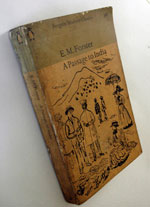 |
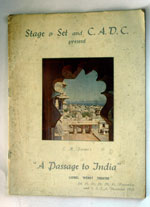 |
| A Passage To India: Santha Rama Rao wrote the stage play based on the Forster novel. An ornamental elephant (below) in his home reminds Mr. Bowden of his years in India. |
The plot is built around the incident of the Marabar Caves, which the two English women visit in the company of Dr. Aziz. Miss Quested has a mysterious, overwhelming psychological experience, alone, inside the caves, and blames Dr. Aziz for it, falsely accusing him of molestation. Scandal, a trial, and a series of personal tragedies in the form of ruined friendships follow, leaving the big open question of whether the British and the Indians – the rulers and the ruled – can ever be true friends.
Russell Bowden had seen a powerful dramatisation of the book done by the Royal Shakespeare Company, in Stratford-on-Avon, and that had started him dreaming of producing the play himself, somewhere, some day.
“It was marvellous, and after seeing it I sent for the play, by Santha Rama Rao, and read it, and it seemed to capture the essence of the novel,” said Russell Bowden, relaxing in his Kottawa, Piliyandala home, surrounded by his beloved books and mementoes of his travels, including an ornamental wood sculpture from India of an elephant carrying passengers on its back – a very cinematic British Raj image.
“That was the inspiration for my wanting to do the play – and also the fact that I am anti-colonial, anti-imperialist, in my politics,” Mr. Bowden said. “E. M. Forster was not overtly anti-colonialist, but it is there in the book and the play, and that attracted me to the work.
“And it seemed sensible to do the play here in Ceylon, where you didn’t have to have Alec Guinness blacked up to be an Indian. You could take Winston Serasinghe as he was. Also, I was very friendly with Ernest McIntyre, who had his own Sinhala theatre group, Stage & Set. Ernest had done the first Sinhala production of Bertolt Brecht, The Caucasian Chalk Circle, in 1966. And that set me thinking I ought to do the play of Forster’s novel.”
 Mr. Bowden’s intellectual partner in his performing arts dreams, Raymond Adlam, played a crucial role throughout. “Raymond was a creative amanuensis. Before we even decided to do the play, we went up to some remote tea estate where a planter had said we could use his bungalow. And we took with us piles of books, and we read and read, and talked and talked. And we went for walks. The deep insights that were needed to do A Passage To India came from Raymond’s intellect and creativity.” Mr. Bowden’s intellectual partner in his performing arts dreams, Raymond Adlam, played a crucial role throughout. “Raymond was a creative amanuensis. Before we even decided to do the play, we went up to some remote tea estate where a planter had said we could use his bungalow. And we took with us piles of books, and we read and read, and talked and talked. And we went for walks. The deep insights that were needed to do A Passage To India came from Raymond’s intellect and creativity.”
Resolved to do the play, Mr. Bowden now had to think about the casting. This should have been a natural process, with available expatriates easily slipping into the British roles and locals playing the Indian characters, but it was not to be as easy as that.
The roles of the English characters had their ready takers, with British teacher Raymond Adlam fitting into the part of English teacher Cyril Fielding like a hand in a tennis glove. But what about the other, complex Indian characters? Who could play them?
“Who should play Aziz? I don’t remember who suggested the late Dhamma Jagoda, but when I approached him, he was extremely nervous,” Mr. Bowden said. “He had never acted in English. He had never been part of the English theatre group. He had never spent much time among English-speaking people. His milieu had always been Sinhala. It took a lot of gentle talking by Raymond and me to persuade him that he was capable of doing it. Raymond would help him with his English, and I told him that I, as director, would be very easy on him. But that wasn’t necessary.
“Dhamma was theatre through and through. His English may in some places have been inhibited by what he understood of the text, but his ability to understand what was required of the character, and to marry the personality of Dhamma with the personality of Aziz – which is, of course, what acting is about – was absolutely first rate. He was a true man of the theatre, a very sensitive actor.
“I had left Sri Lanka when Dhamma set up his drama classes for Sinhala actors. I don’t think many people know how much Dhamma owed to English language theatre. The British Council had arranged drama workshops in which we had people like Rukmani Devi and Douglas Ranasinghe. We ran a workshop on acting and direction with the British director Peter Potter. Dhamma learnt a great deal, and that, I think, was transferred across when he taught in the theatre school he set up. Not many people know of that link.”
A Passage To India was jointly presented, at the close of 1968, by the Ceylon Amateur Drama Club (CADC) and Stage & Set, with actors from the English language and the Sinhala language theatre coming together for only the second time in a major production (the first was The Caucasian Chalk Circle). Raymond Adlam and Dhamma Jagoda were joined by Sally James (as Adela Quested), Marjorie Jayasuriya (as Mrs. Moore), Winston Serasinghe (as Professor Godbole), Ernest McIntyre (as the lawyer, Mr. Amritrao), and Helen McAlpine and Alastair Rosmale-Cocq, among others.
“We did little direction,” Mr. Bowden recalled. “Ernest McIntyre needed little direction, and Winston Serasinghe, as Godbole, gave a much better performance, in my opinion, than Alec Guinness in the same role in David Lean’s film. Guinness was out of his depth playing Godbole, while Winston was superb.”
Mr. Bowden said a lot of thought had gone into the stage design, but even so the sets were incomplete when the curtain went up on the first night, on November 24, 1968 .
The director closely supervised the making of the sets, which were designed by Douglas Jayasinghe, the costumes, designed by Kirti Sri Karunaratne, and the lighting, executed by Herft & Sons.
“Act One shows the living room in Fielding’s home. The set and the lighting had to suggest 4 o’clock on an April afternoon in the early Twenties. Fielding’s house was set up to look like a faded Muslim upper-class residence fallen on hard times, with grand Islamic arches and so on, while Fielding’s furniture was drab government issue, contrasting oddly in a middle-class British way with the former magnificence of the house.
“The Marabar Hills of Act Two, which were to be evoked in a hilly-looking cutout running round the foot of the stage, never materialised, not even on the last day. “To catch the feel of the period, we went on a hectic search in the Pettah for a two-bladed ceiling fan for the court scene in Act Three. The scene opens with the slow movement of Edward Elgar’s Second Symphony as a prelude to Aziz’s downfall, and Fielding’s downfall, and the downfall of almost everyone, except the Raj itself.”
In a way, the sets were a version of the bigger, outdoors “stage sets” the British had created to sustain their idea of themselves playing out their roles in their idea of Imperial India – an illusion that was supported by the work of the distinguished British architect Edwin Lutyens, who created “New Delhi”.
The play ran from the last week of November into the first week of December 1968, a couple of weeks before E. M. Forster’s 90th birthday, which fell on January 1, 1969. The production was offered as a “humble tribute” to the writer. E. M. Forster died 18 months later, on June 7, 1970.
Russell Bowden was reminiscing about Forster’s most famous book on the 40th anniversary, almost to the day, of Forster’s death. He is wistful about the play, 41 years later.
“This is a lost production,” he lamented. “Nobody remembers it. The book ‘Applause at the Wendt’, which sets out to list the major shows at the Lionel Wendt Theatre, fails to make any references to A Passage To India. And yet it ran for 10 performances, the longest run of shows for a Sri Lankan production at the time.
“I remember going into the auditorium one evening during one of the performances, and feeling the warmth of the audience, their concentration, and I remember thinking, yes, we have achieved something. I was trying to be realistic about the amount of work we had put in, and the results of that work.”
Mr. Bowden credits the now forgotten Lionel Wendt Arts Centre Club for providing much of the motivation he needed to put on the show.
“I cannot emphasise enough the role of the club in the conceptualisation, rehearsing and production of the play. The Arts Centre was not just a drinking place. We drank, but not to excess. We talked, obsessively, about theatre. A Passage To India was a major event. My imagination was enriched by what people said over an arakku, a beer, a gin and tonic.
“It was a meeting place for theatre-holics. Regie Siriwardene, Doric de Souza from Peradeniya, knocking down the arakkus, the de Mels of Quickshaws – they were all there. It was a place where intellectuals in the theatre could get together. Dhamma was there. Raymond was there. They were all there.
“The Arts Centre Club played a great role. It was a tragedy that the management allowed it to go broke. A great loss, particularly now that the local theatre is so rich in English language theatre. The meeting ground has gone, and that is very sad. It should be re-sponsored and re-opened. It should be there.” |







 Mr. Bowden’s intellectual partner in his performing arts dreams, Raymond Adlam, played a crucial role throughout. “Raymond was a creative amanuensis. Before we even decided to do the play, we went up to some remote tea estate where a planter had said we could use his bungalow. And we took with us piles of books, and we read and read, and talked and talked. And we went for walks. The deep insights that were needed to do A Passage To India came from Raymond’s intellect and creativity.”
Mr. Bowden’s intellectual partner in his performing arts dreams, Raymond Adlam, played a crucial role throughout. “Raymond was a creative amanuensis. Before we even decided to do the play, we went up to some remote tea estate where a planter had said we could use his bungalow. And we took with us piles of books, and we read and read, and talked and talked. And we went for walks. The deep insights that were needed to do A Passage To India came from Raymond’s intellect and creativity.” 